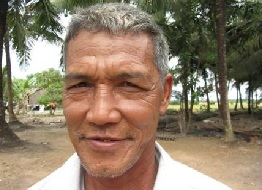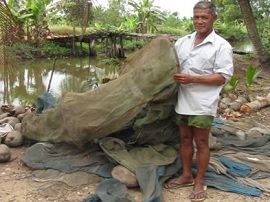Thieng Sao: from illegal fisher to fisheries protector

(03.2013) Illegal fishing is common along Cambodia’s coast. It offers big profits for some and a means of survival for others while posing a challenge for the fisheries administration, community fisheries and local authorities alike. Amongst those who fished using illegal gear and methods such as motorized trawling, flying nets and undersized mesh nets was Thieng Sao. A resident of Preah Sihanouk’s Prey Nup district, his main means of survival for over a decade was illegal fishing along the southern coast of Preah Sihanouk and Kampot provinces.
Sixty-year-old Sao is a well-built man, his muscular arms and legs evidence of a life spent carrying out the tough business of fishing. To generate more income from fishing activities, Sao says he was forced to use illegal gear. But when asked if he had ever been arrested or fined by the local authorizes Sao replied, “No”.
“I told the officers I fished to survive. If I didn’t fish illegally, my family and I would have nothing to eat,” Sao explains. “The patrol officers recognized my face and knew my name so they let me go without charges.”
Yet even long-term illegal fishers can have a change of heart.
“If you can’t beat them, join them,” Sao says and that’s exactly what he did. In 2004 he became president of Chumpou Khmao community fishery (CFi). That same year Sao was also recruited to join a Fisheries Administration (FiA) task force to combat illegal fishing activities. This unpaid job earned Sao the respect of the villagers and FiA alike.
According to Sao, his change of heart was to help save his community from the depletion of fish stocks due to over fishing, much of which was (and still is) carried out by illegal fishers.
“I wanted to use my skills to protect the seas for future generations,” says Sao. “I want to make sure that my grand children can catch enough fish to eat.”
Since joining the task force, Sao and his patrol team members have gone out to sea between two to four times a month, while also carrying out foot patrols twice a month against illegal mangrove cutting. They have succeeded in confiscating fishing gear from illegal fishers, but at times have also exchanged punches. In December 2012, Sao and two fishers set out to sea and confronted illegal fishers in an encounter that became violent.
“The illegal fishers escaped leaving me with bruises and a black eye,” Sao exclaims. Though the team did not catch the men, they did collect some of the fish left behind.
During their many trips to sea, the team has confiscated fishing gear, batteries (used for illegal electric fishing), weapons and bamboo traps of various sizes. They have also made several arrests, imposed fines on fishers and warned them about the consequences of illegal fishing.
Part of the job is to bring the illegal gear back to shore and to report the event to the local authorities. “We tow the heavy fishing gear back to base and pile it up outside my wooden house for display,” says Sao, who claims that since 2004, he has burnt over 1,000 fishing nets. Chumpou Khmao community fishery is one of 15 CFis being supported by the Regional Fisheries Livelihoods Programme (RFLP) which is implemented by the Food and Agriculture Organization of the United Nations (FAO) and funded by the Kingdom of Spain.

RFLP has worked with the CFis to develop resource co-management plans and enhance the livelihoods options for community members. Greater collaboration with government agencies such as FiA has been fostered, while nine wooden patrol boats and four speed boats have also been provided to help combat illegal fishing activities.
FiA officer, Phea Em, 42, recruited Sao to join the patrol team to combat illegal fishing. According to Em the RFLP patrol boats have helped decrease illegal fishing.
“With assistance from RFLP to help strengthen the management capacity of the community fishery (CFi), I’ve observed illegal fishing activities in my district have fallen by 10 to 30 percent,” he says.
After 20 years working for the FiA in Prey Nup district, Em says RFLP is the first and only programme that has provided hands-on training to fishing communities and government staff. Importantly RFLP has sought to establish mechanisms among the authorities and fisheries communities to work together to address resource depletion and other conflicts the villagers encounter. One example, of this enhanced cooperation is the joint patrols carried out by community members and FiA staff.
The capacity of FiA staff has also been built so that they can better manage resources and facilitate livelihoods development. “I was trained in marine survey techniques and good aquaculture practice and it provided me with knowledge that I would not otherwise have gained,” Em says.
When the project comes to an end in August 2013, Em says he will continue to apply the knowledge he has learned. Meanwhile as for Sao, he plans to retire from going to sea. Instead, he plans to become a farmer as age catches up with him and he no longer wishes to face the rigours of fishing. “Rice farming is my alternative occupation,” Sao says, fanning flies off his back.
